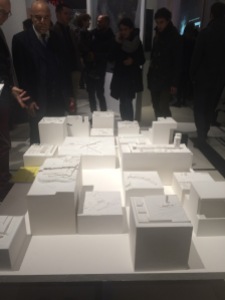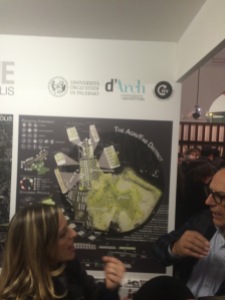


Roma: 2025: Ideas for the New Metropolis
At MAXXI recently (18 December 2015) 25 projects were unveiled for 25 quadrants of greater Rome. Inspired by the 1978 Roma Interrotta project exhibit which saw 12 international architects address the planning of Rome’s historical center, this initiative, titled Rome 20-25: New Life Cycles for the Metropolis addressed the city at a much larger scale.
12 foreign universities, plus 12 Italian ones were invited to work on a 25 kilometers square, gridded into 10k x 10k squares. Yes, that adds up to 24, the central square being left vacant, but late in the game Princeton University was brought on board and given this daunting task.
The research presented in the exhibits, like Rome itself, is heterogeneous and more than a little chaotic. During the inaugural talks one of the presenters (Princeton’s Stan Allen?) observed that the exhibit reflected the structure of the city, and crowded with participants from Rome and all over the world, navigating the narrow warren of passages between the tightly packed exhibition stands, was more like a throwback to the Rome of a medieval jubilee. It warrants a closer look when the crowds die down.
Several of the members of the organizing committee (both Francesco Garofalo and Giovanni Caudo) referred to the disruptive nature of the proposals, creating a paradigm shift away from the 20th century approach to urban planning as property development. All of the projects instead look for systems, treat the city as a quantum rather than linear process, to quote Caudo.
Many of the buzzwords in the presentations are prefaced with “Re” or “Multi.”
They describe strategies for re-enforcing the resilience and resistance of the urban tissue, for re-using existing infrastructure, rethinking, retooling and redesigning more than eradicating and constructing. They speak of multiplicity and multi-culturalism.
The era of big projects is over. In its place we see a culture of dispersion, sharing, viral networking, a culture of interconnected villages which has always been part of Rome’s DNA. The Rome that emerges in this research is about daily life, about the culture of dwelling, (the “abitare” of University of Camerino), of daily life (the “quotidiano” of Roma Tre). It is about infrastructure but not the heavy, costly grey infrastructure of the 20th century but a new soft infrastructure (the “green” and “blue” infrastructure and “slow mobility” of University of Napoli Federico II). It is less about forms and figures than it is about substance and systems (the “energy, food and waste” systems of IUAV).
The discussion of center vs. periphery has final been replaced by a recognition of multiple centers and multiple peripheries.
Landscape, for some time, has been recognized not just as a context for the city’s architecture or an occasional anomaly in its development, but as an alternative to the city. Although Rome was once center of a quasi-global empire whose breadbasket encompassed most of the Mediterranean, at least since its fall it has stood out for the presence of productive agricultural landscape within its city limits, a fact that was highlighted in many of the projects.
Speaking for the Columbia University workshop, Sandro Marpillero noted that the 1978 Roma Interrotta had a devastating effect on American urbanism. It opened the floodgates to neo-liberal strategies for real-estate speculation dressed in formal historicism (at least when I was practicing architecture in the US this was the case). Collage-city, and thus indirectly Rome, provided an alibi for just about anything. Let’s hope that this new metropolitan vision, that privileges ecology, participation and systems thinking, will precipitate an urban transformation in a new, healthier direction.
